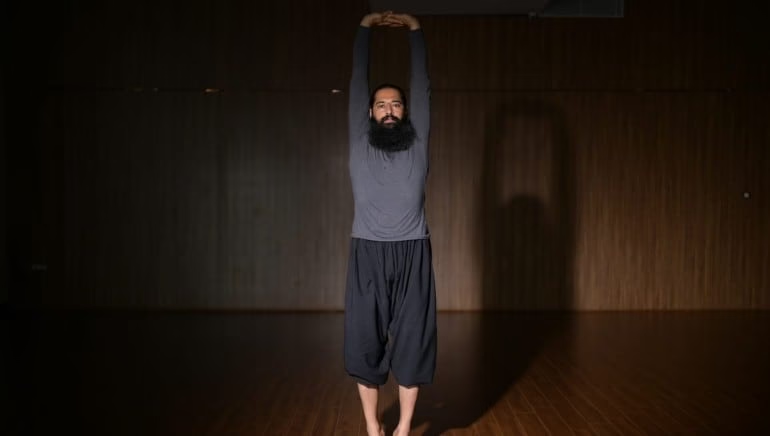Gentle yoga poses for heart attack recovery: Learn how yoga promotes heart health, reduces stress, and enhances well-being in patients.
After a life-altering event such as a heart attack, patients often face a range of emotional and physical challenges. What you eat, how you exercise, ways in which you reduce stress on your mind and body – all of these play a crucial part in maintaining heart health. One practice that can aid in heart health recovery is yoga. This ancient discipline combines physical postures, breath control, and mindfulness. If you or a loved one is navigating life after a heart attack, yoga can be a gentle and supportive way to rebuild strength and promote heart health.
Can you do yoga after a heart attack?
Before beginning yoga for heart attack recovery, it is important to consult with a healthcare provider, especially for those who have recently experienced a heart attack. Once you have clearance, here are some tips to follow, as suggested by Dr Neha Rastogi Panda.
- Choose the right class: Look for yoga classes specifically designed for beginners or tailored to accommodate medical conditions. Restorative and Hatha yoga styles are gentle and suitable for those recovering from injury.
- Find a qualified instructor: A certified yoga instructor with experience in dealing with heart health can provide appropriate guidance and modifications.
- Listen to your body: Start slowly and pay attention to how your body feels. It’s essential to adapt poses or skip those that feel uncomfortable.
- Practice breath control: Deep, slow breathing is a cornerstone of yoga. Focus on inhaling and exhaling fully, which can enhance relaxation and oxygenate the body.
Is yoga good for heart attack patients?
Yoga is more than just a form of exercise. Its benefits combine physical, emotional, and spiritual wellness. For heart attack patients, the benefits of yoga for heart attack recovery are particularly pronounced.
- Reduces stress: Stress can exacerbate heart conditions. Yoga promotes relaxation through deep breathing and meditation, helping to lower stress levels.
- Improves flexibility: After a heart attack, patients may experience muscle stiffness. Yoga poses can improve flexibility and mobility.
- Enhances circulation: “Specific yoga postures promote blood flow, which is essential for maintaining heart health and promoting recovery”, says an Infectious Diseases Doctor.
- Boosts mental health: Yoga encourages mindfulness and can reduce anxiety and depressive symptoms commonly experienced after a heart attack.
- Encourages a healthy lifestyle: Incorporating yoga can inspire healthier habits, including improved diet and lifestyle choices.
Can I do yoga after heart surgery?
Recovering from a heart attack is a deeply personal journey, and resuming activities like yoga should be approached with care, patience, and medical guidance. “In most cases, gentle yoga can be considered after 6 to 8 weeks of recovery. Still, the exact timing depends on the severity of the heart attack, the type of treatment received (such as angioplasty or bypass surgery), and the patient’s overall fitness,” Cardiac and Aortic surgeon Dr Niranjan Hiremath.
Can I do yoga after a heart attack?
“When restarting yoga, it is best to begin with restorative and breathing-focused practices. Avoid fast-paced yoga styles, complex inversions, or positions that require prolonged breath-holding, as these can increase blood pressure or put undue load on the heart,” says Dr Hiremath.
Here are some gentle yoga poses shared by yoga expert Himalayan Siddhaa Akshar. These can be beneficial for individuals recovering from a heart attack.
Sukhasana (easy pose)
- How to do it: Sit cross-legged on the floor with your hands on your knees. Keep your spine straight and shoulders relaxed. Close your eyes and focus on your breath.
- Benefits: Promotes relaxation and stability, helping to calm the mind.
2. Balasana (child’s pose)
- How to do it: Kneel on the floor, sit back on your heels, and stretch your arms forward on the floor. Rest your forehead on the ground.
- Benefits: Releases tension in the back and shoulders, promoting relaxation.

3. Tadasana (mountain pose)
- How to do it: Stand tall with your feet together, arms at your sides. Engage your thighs and stretch your arms overhead with palms facing each other.
- Benefits: Enhances posture and promotes body alignment awareness.
4. Bhujangasana (cobra pose)
- How to do it: Lie on your stomach and place your hands under your shoulders. Inhale, gently lifting your chest while keeping your hips and legs on the ground.
- Benefits: Strengthens the spine and opens the chest, enhancing breathing capacity.
5. Viparita karani (legs-up-the-wall pose)
- How to do it: Sit next to a wall and lie back, stretching your legs up against the wall. Relax your arms by your sides.
- Benefits: Improves circulation and provides deep relaxation, ideal for stress relief.
“One important rule is to never push through pain, dizziness, or shortness of breath. Yoga after a heart attack is not about flexibility or endurance—it is about reconnecting with your body and calming the nervous system. Sessions should be short initially, around 10–15 minutes, gradually increasing as strength and confidence return,” shares the Cardiac and Aortic surgeon.
Is breathing exercise good for heart patients?
Pranayama, or breath control, is a vital aspect of yoga that can significantly benefit heart health, according to a study published in the International Journal of Cardiology.
Here are a couple of simple techniques for yoga for heart attack recovery:
You may also like


- Deep breathing: Inhale deeply through your nose, allowing your abdomen to expand. Then exhale slowly through your mouth. Repeat for several minutes to promote relaxation.
- Nadi shodhana (alternate nostril breathing): This technique helps calm the mind and balance the energy. Close one nostril with your thumb, inhale deeply through the other nostril, then switch. Repeat several cycles.
Does meditation help with heart attacks?
Combining yoga with mindfulness and meditation can further enhance the recovery process. Here are a few practices:
- Guided meditation: Listening to guided meditations focused on healing can provide a sense of peace and relaxation.
- Mindful eating: “Pay attention to what you eat. Nourish your body with heart-healthy foods and appreciate each bite”, says Infectious Diseases Physician.
- Gratitude journaling: Write down things you are grateful for daily, fostering a positive mindset.
- Listen closely to your body: “If any posture causes discomfort in your chest, dizziness, or palpitations, ease out of the pose and rest. Over time, as your strength and endurance improve under professional supervision, you can gradually explore more dynamic styles,” says Interventional Cardiologist Dr Abhijit Borse
What lifestyle modifications are recommended for individuals with cardiac conditions?
Incorporating yoga should be part of a comprehensive approach to heart health, according to a study published in the International Journal of Yoga.
Here are some additional lifestyle changes to consider:
- Healthy eating: Emphasise fruits, vegetables, whole grains, and healthy fats.
- Regular check-ups: Maintain regular contact with your healthcare provider to monitor your heart health.
- Stay Active: In addition to yoga, incorporate other low-impact physical activities, such as walking or swimming, as recommended by your doctor.








